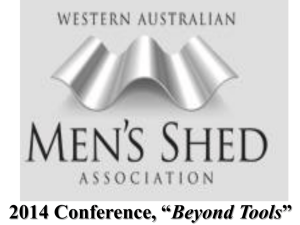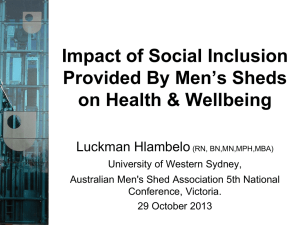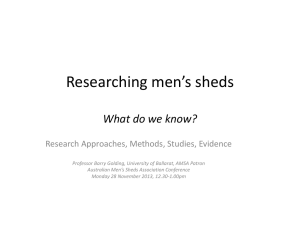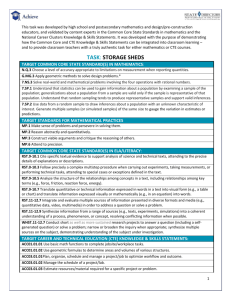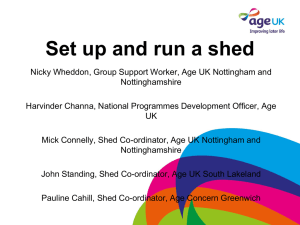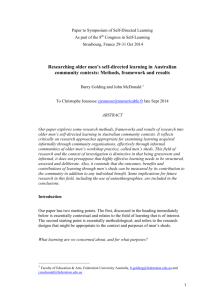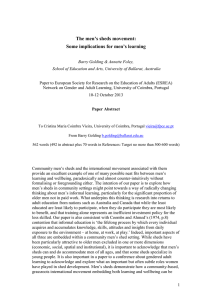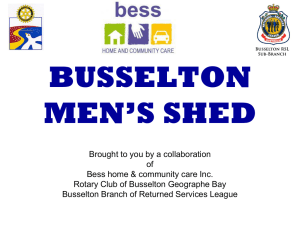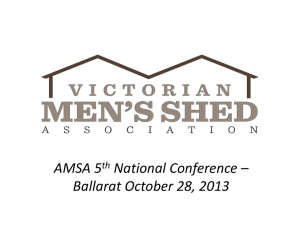Barry Golding
advertisement
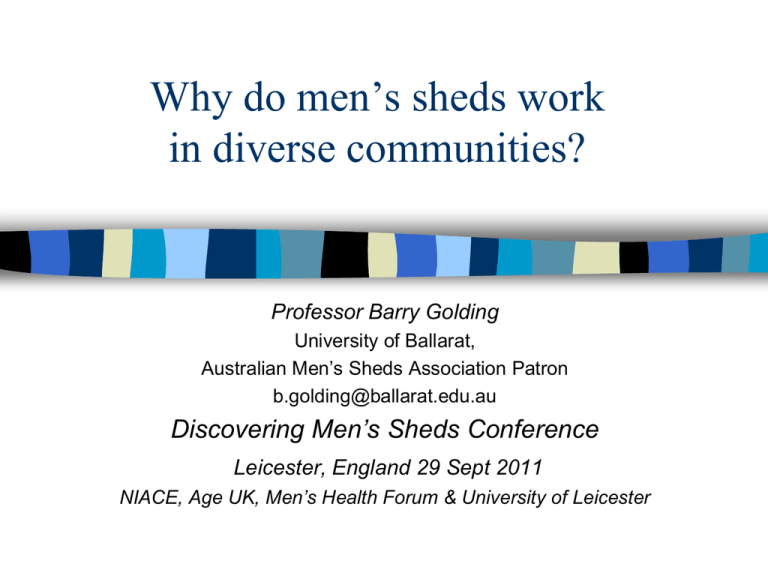
Why do men’s sheds work in diverse communities? Professor Barry Golding University of Ballarat, Australian Men’s Sheds Association Patron b.golding@ballarat.edu.au Discovering Men’s Sheds Conference Leicester, England 29 Sept 2011 NIACE, Age UK, Men’s Health Forum & University of Leicester How come sheds were invented in Australia? Given that: “Australia is by far the driest, smallest, flattest, most infertile, climatically most unpredictable, and biologically most impoverished continent and the last to be occupied by Europeans”, and “… had supported the most distinctive human societies and the least numerous human population, of any continent.” Diamond (2005) Guns, germs and steel. 2 Community men’s sheds are culturally iconic in some nations, springing & spreading in the past 15 years in Australia from: Backyard, house & garden sheds Fire brigade, football and rugby sheds Woodworker’s/turner’s workshops Vietnam & War Veterans organisations Places & organisations where workers want to keep trade skills, traditions, tools & engines alive. Ideas in media & popular texts. Men’s health, learning & wellbeing workers, researchers, activists & gerontologists (Leon Earle). Shed ‘pioneers’ & innovators in all states Men’s sheds, State and national Associations (AMSA) There are now over 600 community men’s sheds across Australia, doubling every two years for the past decade! 3 In the past four years men’s sheds have spread rapidly in Several other Anglophone nations: New Zealand (35?) Ireland (35?) England (50?) Canada (2?) Will they adapt, diversity and spread in other non-Anglophone nations? 4 What are community men’s sheds, as developed in Australia since 1995? Now the largest community association in Australia focused on the needs, health, wellbeing & interests of men. A new ‘movement’ of shed-based community organisations, mainly for and by men. Providing a safe, regular, social space, for informal, voluntary activity & programs with many other possibilities & outcomes. Unlike ‘backyard’ sheds, available to groups of men, independently organised or in auspice arrangements through other community organisations. Usually (but not always) with a group workshop space, tools and equipment a public, shed-type setting As diverse as the men and communities they spring from. 5 First, a restating of the important basics: Sheds work because they are attractive places for men to gather socially, regularly, voluntarily, happily, safely and do hands-on stuff together. They work best when it’s grassroots, local, by, for and about the local men and the community. Shedders are active and equal participants: not students, patients, clients or customers. They should be inclusive and welcoming of all men. They are not patronizing and do not see men as having ‘a deficit’ or being the problem. Not naming the shed activity provides freedom to do & talk about important other stuff (including health). 6 The outcomes are typically diverse and powerful. What do ‘professionals’ see in a shed? A place for: men’s health (health worker) masculinities (gender academic) learning (educator) counseling about behaviour (psychologist) retiring and ageing (a gerontologist) doing stuff (occupational therapist) men to get out of the house (a sociologist) social engagement & connection (community services) tackling substance abuse (drug worker) research (academic) wooing votes (politicians) Men’s lives (and needs) beyond paid work are diverse & do not fit into one, neat, academic box. 7 Sheds work for (and are supported by some governments & professionals) because they: attract men who are otherwise missing (who won’t access services that patronize them) provide places to embed programs and meet men, ‘at home’, on their terms operate and are responsive to diverse men’s diverse needs at a local level. tick all of the Social Determinants of Health provide some services free, cheaper or more effectively than govt (This one needs watching …) 8 Men’s sheds have tended to thrive in: Post-industrial suburban areas Rural and regional areas (where farmers have moved to town or where ex-tradesmen are concentrated) Areas hit by crisis & change (with fire, drought, flood and lower socio-economic status) Areas where the proportion of men ‘beyond paid work (unemployed, out of the workforce, retired) is higher than average. These are the areas and men service providers and governments have difficulty 9 reaching. Men’s sheds must be for all men An important reflection on four men who have suggested otherwise … Racism, homophobia, discrimination on the basis of religion or disability is not acceptable in sport (and is unlawful). A brief reflection on the role and status of women … 10 Women have actively assisted the spread Men with female partners typically participate with their strong support (& encouragement). Women have played major roles in developing & championing many sheds, the movement, plus national & state associations. Almost all major media stories about sheds have been researched and reported by women. Women have been behind many shed start ups & the procurement of funds. Some sheds have a female coordinator. Some sheds make a local decision to include some women as participants. Men sometimes shift the stuff they don’t want to deal with to women (eg paperwork, budgeting, accountability). 11 Other groups of men gather in: most nations, around sport & emergency service organisations Samoa, around the kava bowl Scandinavia, around fishing & hunting Portugal, around pigeon racing Mediterranean counties, around coffee Maldives, where fishing nets are fixed. ‘Sheds’ won’t be needed everywhere, in all nations or for all men, but some of the same principles are transferable. 12 Learning through the national Australian (and State) conferences 1st National Men’s Shed Conference 2005, Lakes Entrance, Victoria, organized by Gary Green & Orbost Men’s Shed. 2nd National Conference Manly NSW, Sept 2007, organized by Lane Cove Men’s Shed & Uniting Church (also Tasmania) 3rd National Conference Hobart, Tasmania: Aug 2009 Organized by AMSA with Pete’s Shed, Bridgewater (also in Western Australia) 4th National Conference Brisbane, Queensland, Aug 2011, organized by AMSA & QMSA, at which the International Confederation of Men’s Sheds Associations was first convened (also in New South Wales, Victoria & South Australia) Leicester ‘Discovering Men’s Sheds’ 29 Sept 2011 5th Conference Melbourne AMSA & VMSA, 2013. 13 In Australia, learning about sheds is through: diverse community-based organisations that auspice sheds & service providers AMSA & state men’s shed associations State Govt Support mainly in Victoria: other states in Australia are likely to follow suit - once more evidence is there of hard outcomes & ‘throughput’ (a double-edged sword …) Federal Govt support of AMSA Non-Government Organisations (eg Rotary, Veterans, Aged-Care, Uniting Care, Catholic Church, Salvation Army) Govt Programs (eg Department of Veterans Affairs, Adult & Community Education; Indigenous; Health & Wellbeing, Local Govt). Shed Forums & Shed Crawls (eg Ballarat 2011) 14 What do men learn in sheds? Hands-on skills through practical, productive activity. The positive value of leisure activity & friendships with other men. Importance of health, fitness, relationships, identities as men & emotional wellbeing. Coping with changes associated with unemployment, separation, ageing, disability & retirement. To develop, share & enjoy lives & identities beyond work & home. 15 Why do sheds work? #1 They positively accommodate men with an aversion to formal education. They encourage mentoring & sharing of leisure, trade, technical, craft, health & safety skills. They match the specific learning needs of the men that use them & make men ‘feel at home’ and valuable. The focus is on the needs of men as joint participants in the activity. 16 Shed-type settings work #2 because they provide opportunities for: active participation & situated, informal learning in communities of (men’s) practice safe, positive, therapeutic & male-positive contexts where men feel ‘at home’. a voluntary social & community outlet for diverse, mainly older men. opportunities for sharing & mentoring opportunities for informally learning how to stay well, fit & healthy new types of collaboration, therefore building better communities. 17 Men learn new ways to: break social isolation & ‘underfoot syndrome’ regularly share workshop-based, hands-on, trade skills with men & sometimes boys give back to their communities model positive and diverse ways of being a man (particularly beyond work) regularly participate & socialise in community settings with other men learn, that does not involve shame. 18 Shed practice informs educators by identifying factors that ‘put men off’ formal learning & keep them unwell & out of work: previous negative experiences of schooling a dislike of formal learning & literacies limited access to education, training & services that match men’s preferred ways of learning limited access to computers & internet age discrimination in employment & training sickness, disability, caring & family roles. 19 ‘Shoulder to shoulder’ activity is: enjoyable, hands-on & practical. doing real tasks, of real & transferable benefit (to individual, group, family, business or community). sometimes outside. about informal mentoring in groups rather than teaching. in places where men already feel ‘at home’, sometimes with other men. sometimes (but not always) in a community shed. 20 Men’s shed fundamentals It has to be voluntary, safe, social and mainly hands-on, for all men & the community. Men who participate in sheds are not clients, customers, patients or students. It is not from a deficit or ageist model. If learning or health are to be introduced it has to be on men’s terms, at their invitation & involving pedagogies which work for men. While women are sometimes involved in some way, the shed practice works best if it’s 21 solely or mainly for & by men. For men (and all adults)… When will governments learn the social (& economic) value of grassroots wellbeing through community organisations rather than just measuring the cost? How can other services be transformed in similar way ways that value participants over clients? 22
